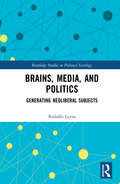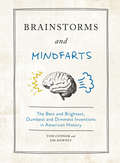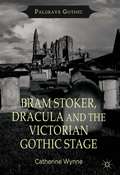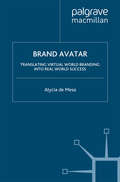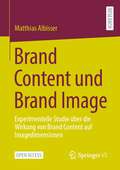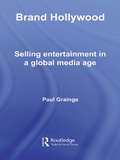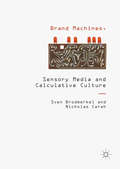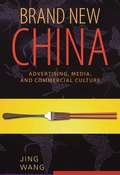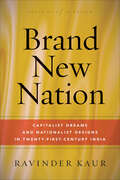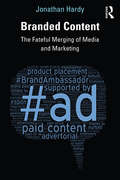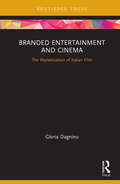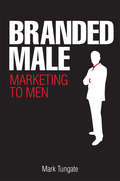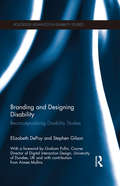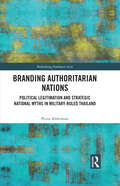- Table View
- List View
Brains, Media and Politics: Generating Neoliberal Subjects (Routledge Studies in Political Sociology)
by Rodolfo LeyvaFollowing the 2007–2008 global financial crisis, a number of prominent academics, journalists, and activists were quick to pronounce the demise of neoliberal capitalism and governance. This rather optimistic prediction, however, underestimated the extent to which neoliberalism has shaped the 21st-century world order and become entrenched in our sociopolitical and cognitive fabric. Indeed, 11 years after the crisis, and in spite of the significant levels of socioeconomic inequality, psychological distress, and environmental destruction generated by neoliberal policies and corresponding business and cultural practices, the ideological hegemony of neoliberalism has not been supplanted, nor has it really faced any serious unsettling. How, then, has neoliberalism inflected and shaped our “common-sense” understandings of what is politically, economically, and culturally viable? To help answer this question, this book combines leading theories from sociology, media-communication research, developmental psychology, and cognitive science, and draws on primary evidence from a unique mix of ethnographic, survey, and experimental studies – of young people’s leisure practices and educational experiences, of young adults’ political socialisation processes in relation to exposure to social networking sites, and of the effects of commercial media viewing on material values and support for social welfare. In doing so, it provides a nuanced and robustly empirically tested account of how the conscious and non-conscious cognitive dimensions of people’s subjectivities and everyday social practices become interpellated through and reproductive of neoliberal ideology. As such, this book will appeal to scholars across the social and behavioural sciences with interests in neoliberalism, political engagement, enculturation, social reproduction, and media effects.
Brains, Media and Politics: Generating Neoliberal Subjects (Routledge Studies in Political Sociology)
by Rodolfo LeyvaFollowing the 2007–2008 global financial crisis, a number of prominent academics, journalists, and activists were quick to pronounce the demise of neoliberal capitalism and governance. This rather optimistic prediction, however, underestimated the extent to which neoliberalism has shaped the 21st-century world order and become entrenched in our sociopolitical and cognitive fabric. Indeed, 11 years after the crisis, and in spite of the significant levels of socioeconomic inequality, psychological distress, and environmental destruction generated by neoliberal policies and corresponding business and cultural practices, the ideological hegemony of neoliberalism has not been supplanted, nor has it really faced any serious unsettling. How, then, has neoliberalism inflected and shaped our “common-sense” understandings of what is politically, economically, and culturally viable? To help answer this question, this book combines leading theories from sociology, media-communication research, developmental psychology, and cognitive science, and draws on primary evidence from a unique mix of ethnographic, survey, and experimental studies – of young people’s leisure practices and educational experiences, of young adults’ political socialisation processes in relation to exposure to social networking sites, and of the effects of commercial media viewing on material values and support for social welfare. In doing so, it provides a nuanced and robustly empirically tested account of how the conscious and non-conscious cognitive dimensions of people’s subjectivities and everyday social practices become interpellated through and reproductive of neoliberal ideology. As such, this book will appeal to scholars across the social and behavioural sciences with interests in neoliberalism, political engagement, enculturation, social reproduction, and media effects.
Brainstorms and Mindfarts: The Best and Brightest, Dumbest and Dimmest Inventions in American History
by Tom Connor Jim DowneyThis informative and occasionally bizarre collection of American inventions will help you discover successful and significant ideas—along with the frivolous and utterly useless ones lost to history. Innovation and entrepreneurism appear inextricably woven into the American DNA. Throughout American history, the great inventors and innovators gazed into the future and saw the products and services that would transform the world. While passionate about creating this new thing called a democracy, our Founding Fathers were also driven to change the way humans lived and worked—to complete everyday tasks faster, easier, and more efficiently.As of 2018, the U.S. Patent & Trademark Office had granted its ten millionth patent. But with over 500,000 applications now being filed annually, fewer than half of these applicants will be granted patents and far fewer still—an estimated one percent—will realize commercial success, according to the Office. Some are flawed by mistakes or missing details, others too ridiculous to take seriously, still others simply ahead of their time.From the brightest and most innovative to the wackiest, most bizarre, and downright crazy, this collection of 100 patents includes funny and informative descriptions and original illustrations, all the while letting you in on what most successful patents have in common, what inspired their creators, and how great inventors view the world.
Bram Stoker and the Gothic: Formations to Transformations (Palgrave Gothic)
by Catherine Wynne'My revenge is just begun! I spread it over centuries, and time is on my side,' warns Dracula. This statement is descriptive of the Gothic genre. Like the Count, the Gothic encompasses and has manifested itself in many forms. Bram Stoker and the Gothic demonstrates how Dracula marks a key moment in the transformation of the Gothic. Harking back to early Gothic's preoccupation with the supernatural, decayed aristocracy and incarceration in gloomy castles, the novel speaks to its own time, but has also transformed the genre, a revitalization that continues to sustain the Gothic today. This collection explores the formations of the Gothic, the relationship between Stoker's work and some of his Gothic predecessors, such as Poe and Wollstonecraft, presents new readings of Stoker's fiction and probes the influences of his cultural circle, before concluding by examining aspects of Gothic transformation from Daphne du Maurier to Stoker's own 'reincarnation' in fiction and biography. Bram Stoker and the Gothic testifies to Stoker's centrality to the Gothic genre. Like Dracula, Stoker's 'revenge' shows no sign of abating.
Bram Stoker, Dracula and the Victorian Gothic Stage (Palgrave Gothic)
by C. WynneBram Stoker, Dracula and the Victorian Gothic Stage re-appraises Stoker's key fictions in relation to his working life. It takes Stoker's work from the margins to centre stage, exploring how Victorian theatre's melodramatic and Gothic productions influenced his writing and thinking.
Brand Avatar: Translating Virtual World Branding into Real World Success
by Alycia de MesaVirtual worlds such as Second Life, have millions of users worldwide. Virtual world "residents" wield huge purchasing power, and use real money in the online economies. Companies as diverse as Adidas, Jean-Paul Gaultier, and MTV have plunged into these unchartered waters to give their brands a virtual presence, using varied strategies.
Brand Content und Brand Image: Experimentelle Studie über die Wirkung von Brand Content auf Imagedimensionen
by Matthias AlbisserIn diesem Open-Access-Buch schlägt Matthias Albisser eine Konzeptualisierung von Brand Content als Botschaften der Unternehmenskommunikation vor, die gleichberechtigt eine Unternehmensperspektive (Imageaufbau) und eine Userperspektive (Mehrwert für User) einnehmen. Anhand einer experimentellen Umfrage wird der Einfluss von informativem (Tipps und Tricks) und unterhaltendem (Memes) Brand Content auf das funktionale und das emotionale Markenimage analysiert.
Brand Hollywood: Selling Entertainment in a Global Media Age
by Paul GraingeFrom the growth in merchandising and product placement to the rise of the movie franchise, branding has become central to the modern blockbuster economy. In a wide-ranging analysis focusing on companies such as Disney, Dolby, Paramount, New Line and, in particular, Warner Bros., Brand Hollywood provides the first sustained examination of the will-to-brand in the contemporary movie business. Outlining changes in the marketing and media environment during the 1990s and 2000s, Paul Grainge explores how the logic of branding has propelled specific kinds of approach to the status and selling of film. Analyzing the practice of branding, the poetics of corporate logos, and the industrial politics surrounding the development of branded texts, properties and spaces - including franchises ranging from Looney Tunes to Lord of the Rings and Harry Potter to The Matrix - Grainge considers the relation of branding to the emergent principle of ‘total entertainment’. Employing an interdisciplinary method drawn from film studies, cultural studies and advertising and media studies, Brand Hollywood demonstrates the complexities of selling entertainment in the global media moment, providing a fresh and engaging perspective on branding’s significance for commercial film and the industrial culture from which it is produced.
Brand Hollywood: Selling Entertainment in a Global Media Age
by Paul GraingeFrom the growth in merchandising and product placement to the rise of the movie franchise, branding has become central to the modern blockbuster economy. In a wide-ranging analysis focusing on companies such as Disney, Dolby, Paramount, New Line and, in particular, Warner Bros., Brand Hollywood provides the first sustained examination of the will-to-brand in the contemporary movie business. Outlining changes in the marketing and media environment during the 1990s and 2000s, Paul Grainge explores how the logic of branding has propelled specific kinds of approach to the status and selling of film. Analyzing the practice of branding, the poetics of corporate logos, and the industrial politics surrounding the development of branded texts, properties and spaces - including franchises ranging from Looney Tunes to Lord of the Rings and Harry Potter to The Matrix - Grainge considers the relation of branding to the emergent principle of ‘total entertainment’. Employing an interdisciplinary method drawn from film studies, cultural studies and advertising and media studies, Brand Hollywood demonstrates the complexities of selling entertainment in the global media moment, providing a fresh and engaging perspective on branding’s significance for commercial film and the industrial culture from which it is produced.
Brand Journalism
by Andy BullResponding to the newly-emerging trend of organisations hiring journalists to create content on their behalf, Brand Journalism is the first comprehensive, practical guide to this hybrid form of traditional journalism, marketing and public relations. This textbook takes a direct and practical approach to the subject, showing journalists and journalism students how they can apply their skills to working for a brand, and showing those who work for non-media organisations how their organisation can acquire the skills necessary to become a multimedia publisher. Areas covered include: • Establishing the audience your brand wants to engage with • Identifying your organisation’s business goals • Developing a brand journalism strategy to help deliver those business goals • Measuring the results of your brand journalism strategy The book also features a wealth of case studies on the subject and offers an invaluable companion website - www.brand-journalism.co.uk.
Brand Journalism
by Andy BullResponding to the newly-emerging trend of organisations hiring journalists to create content on their behalf, Brand Journalism is the first comprehensive, practical guide to this hybrid form of traditional journalism, marketing and public relations. This textbook takes a direct and practical approach to the subject, showing journalists and journalism students how they can apply their skills to working for a brand, and showing those who work for non-media organisations how their organisation can acquire the skills necessary to become a multimedia publisher. Areas covered include: • Establishing the audience your brand wants to engage with • Identifying your organisation’s business goals • Developing a brand journalism strategy to help deliver those business goals • Measuring the results of your brand journalism strategy The book also features a wealth of case studies on the subject and offers an invaluable companion website - www.brand-journalism.co.uk.
Brand Machines, Sensory Media and Calculative Culture
by Nicholas Carah Sven BrodmerkelThis study argues that the defining feature of contemporary advertising is the interconnectedness between consumer participation and calculative media platforms. It critically investigates how audience participation unfolds in an algorithmic media infrastructure in which brands develop media devices to codify, process and modulate human capacities and actions.With the shift from a broadcast to an interactive media system, advertisers have reinvented themselves as the strategic interface between computational media systems and the lived experience and living bodies of consumers. Where once advertising relied predominantly on symbolic appeals to affect consumers, it now centres on the use of computational devices that codify, monitor, analyse and control their behaviours. Advertisers have worked to stimulate and harness consumer participation for several generations. Consumers undertook the productive work of making brands a part of their cultural identities and practices. With the emergence of a computational mode of advertising consumer participation extends beyond the expressive activity of creating and circulating meaning. It now involves making the lived experience and the living body available to the experimental capacities of media platforms and devices. In this mode of advertising brands become techno-cultural processes that integrate calculative and cultural functions. Brand Machines, Sensory Media and Calculative Culture conceptualises and theorises these significant changes in advertising. It takes consumer participation and its interconnectedness with calculative media platforms as the fundamental aspect of contemporary advertising and critically investigates how advertising, consumer participation and technology are interrelated in creating and facilitating lived experiences that create value for brands.
Brand New China: Advertising, Media, and Commercial Culture
by Jing WangOne part riveting account of fieldwork and one part rigorous academic study, Brand New China offers a unique perspective on the advertising and marketing culture of China. Jing Wang’s experiences in the disparate worlds of Beijing advertising agencies and the U.S. academy allow her to share a unique perspective on China during its accelerated reintegration into the global market system. Brand New China offers a detailed, penetrating, and up-to-date portrayal of branding and advertising in contemporary China. Wang takes us inside an advertising agency to show the influence of American branding theories and models. She also examines the impact of new media practices on Chinese advertising, deliberates on the convergence of grassroots creative culture and viral marketing strategies, samples successful advertising campaigns, provides practical insights about Chinese consumer segments, and offers methodological reflections on pop culture and advertising research. This book unveils a “brand new” China that is under the sway of the ideology of global partnership while struggling not to become a mirror image of the United States. Wang takes on the task of showing where Western thinking works in China, where it does not, and, perhaps most important, where it creates opportunities for cross-fertilization. Thanks to its combination of engaging vignettes from the advertising world and thorough research that contextualizes these vignettes, Brand New China will be of interest to industry participants, students of popular culture, and the general reading public interested in learning about a rapidly transforming Chinese society.
Brand New Nation: Capitalist Dreams and Nationalist Designs in Twenty-First-Century India (South Asia in Motion)
by Ravinder KaurA Financial Times Best Book of the Year The first book that examines India's mega-publicity campaigns to theorize the global transformation of the nation-state into an attractive investment destination. The early twenty-first century was an optimistic moment of global futures-making. The chief narrative was the emergence of the BRICS nations—leading stars in the great spectacle of capitalist growth stories, branded afresh as resource-rich hubs of untapped talent and potential, and newly opened up for foreign investments. The old third-world nations were rapidly embracing the script of unbridled capitalism in the hope of arriving on the world stage. If the tantalizing promise of economic growth invited entrepreneurs to invest in the nation's exciting futures, it offered utopian visions of "good times," and even restoration of lost national glory, to the nation's citizens. Brand New Nation reaches into the past and, inevitably, the future of this phenomenon as well as the fundamental shifts it has wrought in our understanding of the nation-state. It reveals the on-the-ground experience of the relentless transformation of the nation-state into an "attractive investment destination" for global capital. As Ravinder Kaur provocatively argues, the brand new nation is not a mere nineteenth century re-run. It has come alive as a unified enclosure of capitalist growth and nationalist desire in the twenty-first century. Today, to be deemed an attractive nation-brand in the global economy is to be affirmed as a proper nation. The infusion of capital not only rejuvenates the nation; it also produces investment-fueled nationalism, a populist energy that can be turned into a powerful instrument of coercion. Grounded in the history of modern India, the book reveals the close kinship among identity economy and identity politics, publicity and populism, and violence and economic growth rapidly rearranging the liberal political order the world over.
Brand Protection and the Global Risk of Product Counterfeits: A Total Business Solution Approach
Product counterfeits and other brand infringements represent a growing and substantial risk to firms, consumers, and society. While policing such illicit activity is important, there is much that firms can do to protect themselves and their customers. Grounded in field research and practice, this book presents a total business solution approach to brand protection that enables firms to prevent infringement from occurring and respond efficiently when it does.This total business solution provides a framework for building and advancing brand protection programs that are strategic, comprehensive, and evidence based. Coupling perspectives and illustrations from several academic disciplines and industries, this book serves as a road map or blueprint for companies to develop and implement a proactive strategy to protect their brands. It serves as a guide to help firms continuously learn, innovate, and efficiently allocate resources in a way that maximizes brand protection performance.Graduate and executive education programs and scholars in business, law and criminal justice will benefit from adopting Brand Protection and the Global Risk of Product Counterfeits as course reading, research or a valued addition to their personal library. Brand protection practitioners in firms large and small, working in brand protection, security, supply chain, legal, quality assurance, packaging, C-suite, marketing, sales, and related areas will find this book essential in helping them develop a roadmap for establishing a robust brand protection program and take their existing brand protection to the next level of effectiveness and efficiency.
Branded Content: The Fateful Merging of Media and Marketing
by Jonathan HardyThis is a critical study of the changing relationship between media and marketing communications in the digital age. It examines the growth of content funded by brands, including brands’ own media, native advertising, and the integration of branded content across film, television, journalism and publishing, online, mobile, and social media. This ambitious historical, empirical, and theoretical study examines industry practices, policies, and ‘problems’, advancing a framework for analysis of communications governance. Featuring examples from the UK, US, EU, Asia, and other regions, it illustrates and explains industry practices, forms, and formats and their relationship with changing market conditions, policies, and regulation. The book provides a wide-ranging and incisive guide to contemporary advertising and media practices, to different arguments and perspectives on these practices arising in industry, policy, and academic contexts, and to the contribution made by critical scholarship, past and present. It also offers a critical review of industry, regulatory, societal, and academic literatures.Jonathan Hardy examines the erosion of the principle of separating advertising and media and calls for a new framework for distinguishing marketing communications across 21st-century communications. With a focus on key issues in industry, policy, and academic contexts, this is essential reading for students of media industries, advertising, marketing, and digital media.
Branded Content: The Fateful Merging of Media and Marketing
by Jonathan HardyThis is a critical study of the changing relationship between media and marketing communications in the digital age. It examines the growth of content funded by brands, including brands’ own media, native advertising, and the integration of branded content across film, television, journalism and publishing, online, mobile, and social media. This ambitious historical, empirical, and theoretical study examines industry practices, policies, and ‘problems’, advancing a framework for analysis of communications governance. Featuring examples from the UK, US, EU, Asia, and other regions, it illustrates and explains industry practices, forms, and formats and their relationship with changing market conditions, policies, and regulation. The book provides a wide-ranging and incisive guide to contemporary advertising and media practices, to different arguments and perspectives on these practices arising in industry, policy, and academic contexts, and to the contribution made by critical scholarship, past and present. It also offers a critical review of industry, regulatory, societal, and academic literatures.Jonathan Hardy examines the erosion of the principle of separating advertising and media and calls for a new framework for distinguishing marketing communications across 21st-century communications. With a focus on key issues in industry, policy, and academic contexts, this is essential reading for students of media industries, advertising, marketing, and digital media.
Branded Entertainment and Cinema: The Marketisation of Italian Film (Routledge Critical Advertising Studies)
by Gloria DagninoThe history of Italian cinema is mostly regarded as a history of Italian auteurs. This book takes a different standpoint, looking at Italian cinema from the perspective of an unusual, but influential actor: advertisers. From the iconic Vespa scooter and the many other Made in Italy products placed in domestic and international features, to Carosello’s early format of branded entertainment, up through the more recent brand integration cases in award-winning titles like The Great Beauty, the Italian film and advertising industries have frequently and significantly intersected, in ways that remain largely unexplored by academic research. This book contributes to fill this gap, by focusing on the economic and cultural influence that advertising and advertisers’ interests have been exerting on Italian film production between the post-war period and the 2010s. Increasingly market-oriented film policies, ongoing pressure from Hollywood competition, and the abnormal economic as well as political power held by Italian ad-funded broadcasters are among the key points addressed by the book. In addition to a macro-level political economic analysis, the book draws on exclusive interviews with film producers and promotional intermediaries to provide a meso level analysis of the practices and professional cultures of those working at the intersection of Italian film and advertising industries. Providing an in-depth yet clear and accessible overview of the political and economic dynamics driving the Italian media landscape towards unprecedented forms of marketisation, this is a valuable resource for academics and students in the fields of film and media studies, marketing, advertising, and Italian studies.
Branded Entertainment and Cinema: The Marketisation of Italian Film (Routledge Critical Advertising Studies)
by Gloria DagninoThe history of Italian cinema is mostly regarded as a history of Italian auteurs. This book takes a different standpoint, looking at Italian cinema from the perspective of an unusual, but influential actor: advertisers. From the iconic Vespa scooter and the many other Made in Italy products placed in domestic and international features, to Carosello’s early format of branded entertainment, up through the more recent brand integration cases in award-winning titles like The Great Beauty, the Italian film and advertising industries have frequently and significantly intersected, in ways that remain largely unexplored by academic research. This book contributes to fill this gap, by focusing on the economic and cultural influence that advertising and advertisers’ interests have been exerting on Italian film production between the post-war period and the 2010s. Increasingly market-oriented film policies, ongoing pressure from Hollywood competition, and the abnormal economic as well as political power held by Italian ad-funded broadcasters are among the key points addressed by the book. In addition to a macro-level political economic analysis, the book draws on exclusive interviews with film producers and promotional intermediaries to provide a meso level analysis of the practices and professional cultures of those working at the intersection of Italian film and advertising industries. Providing an in-depth yet clear and accessible overview of the political and economic dynamics driving the Italian media landscape towards unprecedented forms of marketisation, this is a valuable resource for academics and students in the fields of film and media studies, marketing, advertising, and Italian studies.
Branded Male: Marketing to Men
by Mark TungateThe male market is exploding. Thanks to emerging social and cultural trends, men are becoming consumers to reckon with. In 1990 only 4% of men claimed to regularly use a skin care product. By 2015 the figure will have risen to 50%.Branded Male discusses the evolution of the male consumer and the desire of marketers to tap into the still underdeveloped male market. Crammed with facts and anecdotes, it analyzes how to effectively brand products and services for the male market. Using a typical modern male's weekday as a template and examining all the influences affecting him, Branded Male considers his exposure to brands and the ways marketers can exploit these channels, taking you through popular strategies for marketing to men.In his trademark style, Mark Tungate paints a portrait of the male consumer. From razor blades to beer, from aftershave to hotels, he finds out which marketing messages have the most impact on male wallets. Men's bank balances may never be the same again.
Branding and Designing Disability: Reconceptualising Disability Studies (Routledge Advances in Disability Studies)
by Elizabeth DePoy Stephen GilsonOver the past fifty years, design and branding have become omnipotent in the market and have made their way to other domains as well. Given their potential to divide humans into categories and label their worth and value, design and branding can wield immense but currently unharnessed powers of social change. Groups designed as devalued can be undesigned, redesigned and rebranded to seamlessly and equivalently participate in community, work and civic life. This innovative book argues that disability as a concept and category is created, reified, and segregated through current design and branding that begs for creative change. Transcending models of disability that locate it either as an embodied medical condition or as a socially constructed entity, this book challenges the very existence and usefulness of the category itself. Proposing and illustrating creative and responsible design, DePoy and Gilson include thinking and action strategies that are useful and potent for "undesigning", redesigning, and rebranding to meet the full range of human needs and to enhance full participation in local through global communities. Divided into two parts, the first section presents a critical examination of disability as a designed and branded phenomenon, exploring what exactly is being designed and branded and how. The second part investigates the redesign of disability and provides principles for redesign and rebranding illustrated with examples from high-tech to place-based sustainable strategies. The book provides a unique and contemporary framework for thinking about disability as well as providing relevant design and branding guidance to designers and engineers interested in embodiment issues.
Branding and Designing Disability: Reconceptualising Disability Studies (Routledge Advances in Disability Studies)
by Elizabeth DePoy Stephen GilsonOver the past fifty years, design and branding have become omnipotent in the market and have made their way to other domains as well. Given their potential to divide humans into categories and label their worth and value, design and branding can wield immense but currently unharnessed powers of social change. Groups designed as devalued can be undesigned, redesigned and rebranded to seamlessly and equivalently participate in community, work and civic life. This innovative book argues that disability as a concept and category is created, reified, and segregated through current design and branding that begs for creative change. Transcending models of disability that locate it either as an embodied medical condition or as a socially constructed entity, this book challenges the very existence and usefulness of the category itself. Proposing and illustrating creative and responsible design, DePoy and Gilson include thinking and action strategies that are useful and potent for "undesigning", redesigning, and rebranding to meet the full range of human needs and to enhance full participation in local through global communities. Divided into two parts, the first section presents a critical examination of disability as a designed and branded phenomenon, exploring what exactly is being designed and branded and how. The second part investigates the redesign of disability and provides principles for redesign and rebranding illustrated with examples from high-tech to place-based sustainable strategies. The book provides a unique and contemporary framework for thinking about disability as well as providing relevant design and branding guidance to designers and engineers interested in embodiment issues.
Branding Authoritarian Nations: Political Legitimation and Strategic National Myths in Military-Ruled Thailand (Rethinking Southeast Asia)
by Petra AldermanBranding Authoritarian Nations offers a novel approach to the study of nation branding as a strategy for political legitimation in authoritarian regimes using the example of military-ruled Thailand. The book argues that nation branding is a political act that is integral to state legitimation processes, particularly in the context of authoritarian regimes. It applies its alternative reading of nation branding to eight different sectors: tourism, economy, foreign direct investment, foreign policy, education, culture, public relations, and the private sector. The author explains that nation branding produces specific kinds of applied national myths, referred to as ‘strategic national myths.’ She shows that nation branding is an inherently inward-looking strategy aimed at shaping the social attitudes and behaviours of the nation’s citizens in line with the government’s domestic agenda and legitimation needs. Providing the first comprehensive analysis of nation branding in Thailand and the first book-length account of the country’s political developments since the 2014–2019 military rule, the book is primarily aimed at academics in the disciplines of politics, international relations, communication, and area studies as well as business, cultural, and intercultural studies.
Branding Authoritarian Nations: Political Legitimation and Strategic National Myths in Military-Ruled Thailand (Rethinking Southeast Asia)
by Petra AldermanBranding Authoritarian Nations offers a novel approach to the study of nation branding as a strategy for political legitimation in authoritarian regimes using the example of military-ruled Thailand. The book argues that nation branding is a political act that is integral to state legitimation processes, particularly in the context of authoritarian regimes. It applies its alternative reading of nation branding to eight different sectors: tourism, economy, foreign direct investment, foreign policy, education, culture, public relations, and the private sector. The author explains that nation branding produces specific kinds of applied national myths, referred to as ‘strategic national myths.’ She shows that nation branding is an inherently inward-looking strategy aimed at shaping the social attitudes and behaviours of the nation’s citizens in line with the government’s domestic agenda and legitimation needs. Providing the first comprehensive analysis of nation branding in Thailand and the first book-length account of the country’s political developments since the 2014–2019 military rule, the book is primarily aimed at academics in the disciplines of politics, international relations, communication, and area studies as well as business, cultural, and intercultural studies.
Branding Berlin: From Division to the Cultural Capital of Europe (Routledge Research in Cultural and Media Studies)
by Katrina SarkThis book is a cultural history of post-Wall urban, social, political, and cultural transformations in Berlin. Branding Berlin: From Division to the Cultural Capital of Europe presents a cultural analysis of Berlin’s cultural production, including literature, film, memoirs and non-fiction works, art, media, urban branding campaigns, and cultural diversity initiatives put forth by the Berlin Senate, and allows readers to understand the various changes that transformed the formerly divided city of voids into a hip cultural capital. The book examines Berlin’s branding, urban-economic development, and its search for a post-Wall identity by focusing on manifestations of nostalgic longing in documentary films and other cultural products. Building on the sociological research of urban branding and linking it with an interpretive analysis of cultural products generated in Berlin during that time, the author examines the intersections and tensions between the nostalgic views of the past and the branded images of Berlin’s present and future. This insightful and innovative work will interest scholars and students of cultural and media studies, branding and advertising, urban communication, film studies, visual culture, tourism, and cultural memory.
